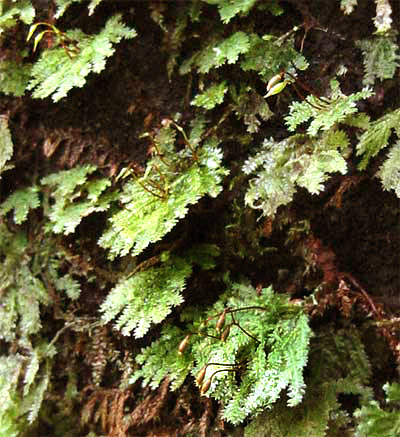Excerpts from Jim Conrad's
Naturalist Newsletter
from the December 10, 2007 Newsletter issued from Yerba Buena Clinic just outside Pueblo Nuevo Solistahuacan, Chiapas, MÉXICO
about 1740 meters in elevation, ± LAT. 17° 11' 27"N, LONG. -92° 53' 35"W
FAN-LIKE MOSSES

I remember what it was like when I first entered Yerba Buena's intact cloudforest back in the 70s or 80s. It was a fairyland of low trees with gnarled branches completely enshrouded in lichens, mosses, ferns, bromeliads and orchids. The ground was wet and spongy with dewy mosses, club-mosses, liverworts and other highly specialized plants adapted to this very special, habitually cool, extremely humid environment.
Last Tuesday, inside the cloudforest zone, in certain coves with steep sides, there were hints of what the forest used to be like. Despite the intense, crystalline, high-elevation sunlight, an icy feeling permeated the air. In the still air, steam from my breath and exercised body rose straight up, vividly billowing against the forest's black shadows. It was so silent that the silence was like a noise, the buzzing of a renegade fly from the neighboring pasture uncannily loud and persistent.
The shaded tree trunk next to me was encased in a kind of fan-shaped moss I've not seen lower down, shown above.
Most mosses are cylindrical, with spore-producing capsules arising from their tops. You almost don't want to believe that what's in the picture is a moss until you notice the capsules, which are quintessential moss reproductive structures. You can review my page on moss structure at www.backyardnature.net/mosses.htm.